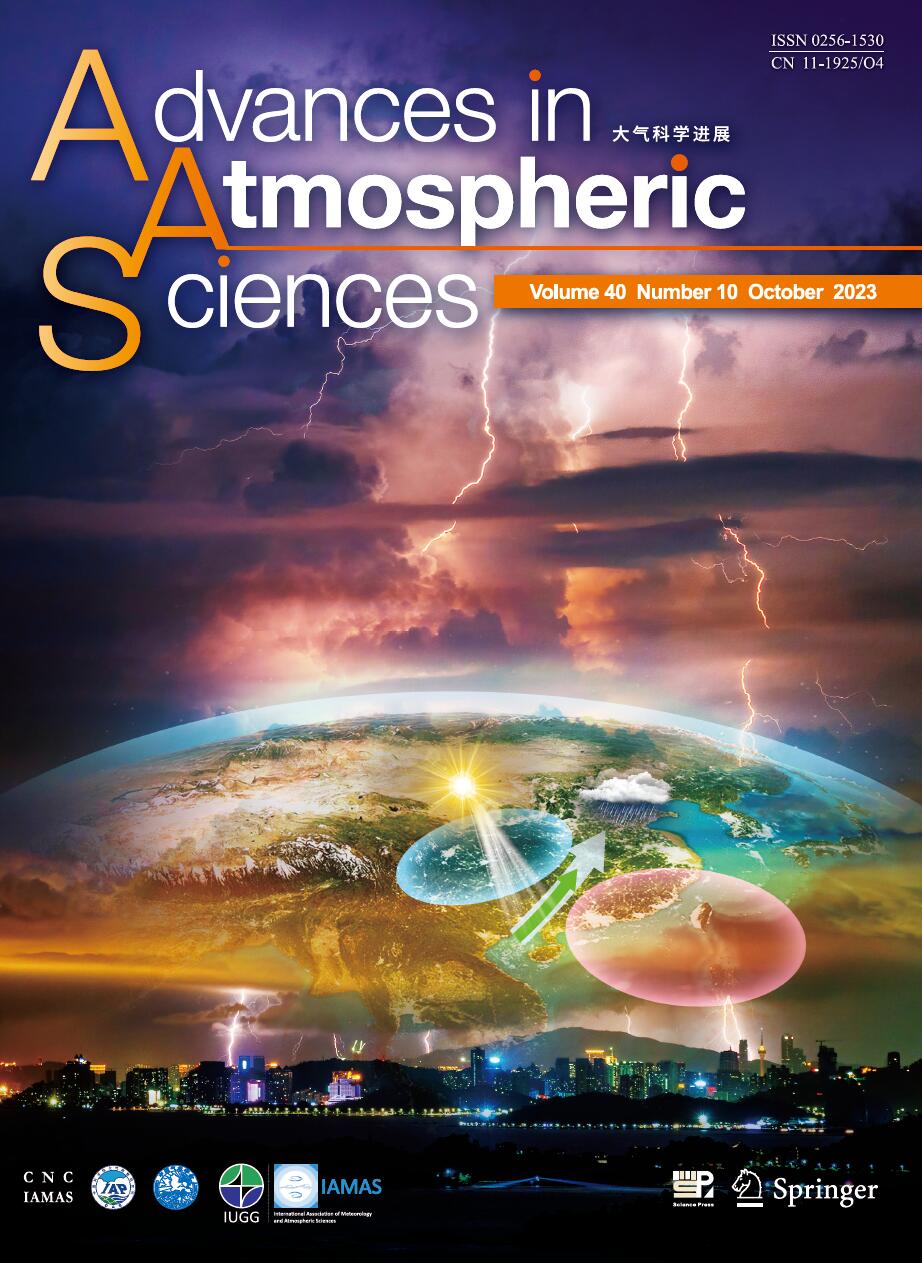| [1] |
Xinyi XING, Xianghui FANG, Da PANG, Chaopeng JI,
2024: Seasonal Variation of the Sea Surface Temperature Growth Rate of ENSO, ADVANCES IN ATMOSPHERIC SCIENCES, 41, 465-477.
doi: 10.1007/s00376-023-3005-x
|
| [2] |
LI Gang*, LI Chongyin, TAN Yanke, and BAI Tao,
2014: The Interdecadal Changes of South Pacific Sea Surface Temperature in the Mid-1990s and Their Connections with ENSO, ADVANCES IN ATMOSPHERIC SCIENCES, 31, 66-84.
doi: 10.1007/s00376-013-2280-3
|
| [3] |
Yadi LI, Xichen LI, Juan FENG, Yi ZHOU, Wenzhu WANG, Yurong HOU,
2024: Uncertainties of ENSO-related Regional Hadley Circulation Anomalies within Eight Reanalysis Datasets, ADVANCES IN ATMOSPHERIC SCIENCES, 41, 115-140.
doi: 10.1007/s00376-023-3047-0
|
| [4] |
Jingrui YAN, Wenjun ZHANG, Suqiong HU, Feng JIANG,
2024: Different ENSO Impacts on Eastern China Precipitation Patterns in Early and Late Winter Associated with Seasonally-Varying Kuroshio Anticyclonic Anomalies, ADVANCES IN ATMOSPHERIC SCIENCES.
doi: 10.1007/s00376-023-3196-1
|
| [5] |
Ning JIANG, Congwen ZHU,
2021: Seasonal Forecast of South China Sea Summer Monsoon Onset Disturbed by Cold Tongue La Niña in the Past Decade, ADVANCES IN ATMOSPHERIC SCIENCES, 38, 147-155.
doi: 10.1007/s00376-020-0090-y
|
| [6] |
Yang AI, Ning JIANG, Weihong QIAN, Jeremy Cheuk-Hin LEUNG, Yanying CHEN,
2022: Strengthened Regulation of the Onset of the South China Sea Summer Monsoon by the Northwest Indian Ocean Warming in the Past Decade, ADVANCES IN ATMOSPHERIC SCIENCES, 39, 943-952.
doi: 10.1007/s00376-021-1364-8
|
| [7] |
Yawen DUAN, Peili WU, Xiaolong CHEN, Zhuguo MA,
2018: Assessing Global Warming Induced Changes in Summer Rainfall Variability over Eastern China Using the Latest Hadley Centre Climate Model HadGEM3-GC2, ADVANCES IN ATMOSPHERIC SCIENCES, 35, 1077-1093.
doi: 10.1007/s00376-018-7264-x
|
| [8] |
WANG Zhiren, WU Dexing, CHEN Xue'en, QIAO Ran,
2013: ENSO Indices and Analyses, ADVANCES IN ATMOSPHERIC SCIENCES, 30, 1491-1506.
doi: 10.1007/s00376-012-2238-x
|
| [9] |
Xiaofei WU, Jiangyu MAO,
2019: Decadal Changes in Interannual Dependence of the Bay of Bengal Summer Monsoon Onset on ENSO Modulated by the Pacific Decadal Oscillation, ADVANCES IN ATMOSPHERIC SCIENCES, 36, 1404-1416.
doi: 10.1007/s00376-019-9043-8
|
| [10] |
Yuanhai FU, Zhongda LIN, Tao WANG,
2021: Simulated Relationship between Wintertime ENSO and East Asian Summer Rainfall: From CMIP3 to CMIP6, ADVANCES IN ATMOSPHERIC SCIENCES, 38, 221-236.
doi: 10.1007/s00376-020-0147-y
|
| [11] |
ZHENG Fei, ZHU Jiang, Rong-Hua ZHANG, ZHOU Guangqing,
2006: Improved ENSO Forecasts by Assimilating Sea Surface Temperature Observations into an Intermediate Coupled Model, ADVANCES IN ATMOSPHERIC SCIENCES, 23, 615-624.
doi: 10.1007/s00376-006-0615-z
|
| [12] |
Zhou Tianjun, Yu Rucong, Li Zhaoxin,
2002: ENSO-Dependent and ENSO-Independent Variability over the Mid-Latitude North Pacific: Observation and Air-Sea Coupled Model Simulation, ADVANCES IN ATMOSPHERIC SCIENCES, 19, 1127-1147.
doi: 10.1007/s00376-002-0070-4
|
| [13] |
Shang-Ping XIE, Yu KOSAKA, Yan DU, Kaiming HU, Jasti S. CHOWDARY, Gang HUANG,
2016: Indo-Western Pacific Ocean Capacitor and Coherent Climate Anomalies in Post-ENSO Summer: A Review, ADVANCES IN ATMOSPHERIC SCIENCES, 33, 411-432.
doi: 10.1007/s00376-015-5192-6
|
| [14] |
Shi Neng, Chen Luwen, Xia Dongdong,
2002: A Preliminary Study on the Global Land Annual Precipitation Associated with ENSO during 1948-2000, ADVANCES IN ATMOSPHERIC SCIENCES, 19, 993-1003.
doi: 10.1007/s00376-002-0060-6
|
| [15] |
CHEN Shangfeng, CHEN Wen, WEI Ke,
2013: Recent Trends in Winter Temperature Extremes in Eastern China and their Relationship with the Arctic Oscillation and ENSO, ADVANCES IN ATMOSPHERIC SCIENCES, 30, 1712-1724.
doi: 10.1007/s00376-013-2296-8
|
| [16] |
HUANG Ping, HUANG Ronghui,
2009: Delayed Atmospheric Temperature Response to ENSO SST: Role of High SST and the Western Pacific, ADVANCES IN ATMOSPHERIC SCIENCES, 26, 343-351.
doi: 10.1007/s00376-009-0343-2
|
| [17] |
Peng HU, Wen CHEN, Shangfeng CHEN, Lin WANG, Yuyun LIU,
2022: The Weakening Relationship between ENSO and the South China Sea Summer Monsoon Onset in Recent Decades, ADVANCES IN ATMOSPHERIC SCIENCES, 39, 443-455.
doi: 10.1007/s00376-021-1208-6
|
| [18] |
ZHOU Lian-Tong, Chi-Yung TAM, ZHOU Wen, Johnny C. L. CHAN,
2010: Influence of South China Sea SST and the ENSO on Winter Rainfall over South China, ADVANCES IN ATMOSPHERIC SCIENCES, 27, 832-844.
doi: 10.1007/s00376--009-9102-7
|
| [19] |
FENG Juan*, CHEN Wen,
2014: Interference of the East Asian Winter Monsoon in the Impact of ENSO on the East Asian Summer Monsoon in Decaying Phases, ADVANCES IN ATMOSPHERIC SCIENCES, 31, 344-354.
doi: 10.1007/s00376-013-3118-8
|
| [20] |
Fei ZHENG, Jianping LI, Ruiqiang DING,
2017: Influence of the Preceding Austral Summer Southern Hemisphere Annular Mode on the Amplitude of ENSO Decay, ADVANCES IN ATMOSPHERIC SCIENCES, 34, 1358-1379.
doi: 10.1007/s00376-017-6339-4
|















 AAS Website
AAS Website 
 AAS WeChat
AAS WeChat 
 DownLoad:
DownLoad: